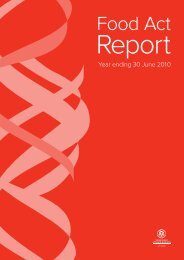Public Health and Communicable Diseases - SA Health - SA.Gov.au
Public Health and Communicable Diseases - SA Health - SA.Gov.au
Public Health and Communicable Diseases - SA Health - SA.Gov.au
You also want an ePaper? Increase the reach of your titles
YUMPU automatically turns print PDFs into web optimized ePapers that Google loves.
number of people living in areas of higher denguerisk, from 1.5 billion in 1990 to about 50-60% of globalpopulation in 2085 8 . In Australia, most notified cases ofdengue are from north Queensl<strong>and</strong>, where the vectormosquito Aedes aegypti is endemic. The two mostserious epidemics noted in Queensl<strong>and</strong> during the lastdecade were in 1998 <strong>and</strong> 2003 respectively (Figure 1),with more than 1,100 cases notified. To date, denguehas not c<strong>au</strong>sed outbreaks in southern parts of Australia.However, a recent study suggested that there might bea dengue threat for southern parts of Australia in thefuture. 9Other Flavivirus infections include Japanese encephalitis,Murray Valley encephalitis (MVE) <strong>and</strong> Kunjin (KUN) virusinfection with less than 100 notified cases annually inAustralia (Figure 1). For MVE <strong>and</strong> KUN viruses, the majorvector is Culex annulirostris, which breeds in freshwater.Most cases in this category are notified in northernAustralia. There has been only one case of MVE notifiedin South Australia during the last five years. Attentionshould be given to Japanese encephalitis in Australiain order to keep it under control. 10 This is particularlyimportant in north Queensl<strong>and</strong>. <strong>Health</strong> professionalsneed to keep alert for the potential transmissionof Japanese encephalitis, including correct clinicaldiagnosis, health information sharing <strong>and</strong> exchange, <strong>and</strong>health education <strong>and</strong> promotion.MalariaAustralia has claimed to be malaria free since 1983.Since then all notified cases of malaria are believed to beimported <strong>and</strong> the notified cases have remained relativelystable during the last ten years, with around 700 casesper year (Figure 1). While there is currently no evidencefor local transmission of malaria within Australia, thereis potential for this to occur in view of the presence ofthe main mosquito vector Anopheles far<strong>au</strong>ti. Studiesindicate that increases in the incidence of malaria arestrongly associated with higher temperatures <strong>and</strong>increased rainfall. In Australia, the length <strong>and</strong> intensity ofwet seasons have a significant effect on the distributionof Anopheles far<strong>au</strong>ti. 11 Climate modelling shows thatglobal warming will enlarge the potential range of thisvector, which could extend, by 2030, to a location 800km south of its present limit in Queensl<strong>and</strong>. 12 Therefore,Australian health professionals should remain alert forthis potential risk.Situation in South AustraliaIn South Australia, RRV is the most important vectorbornedisease. There have been more than 1,600 RRVcases notified in the last ten years with the highestnumber occurring in the year 1997 (635 notified cases).There were four epidemics in the period 1992-2003,with the majority of cases acquired from regions alongthe River Murray. There was some evidence of spreadof the disease to regions in which activity of RRV hadnot been previously recognised, such as the Mid-North<strong>and</strong> the South-East 13 . In terms of disease distributionamongst the population, it was found that the highestrates occurred in the 30–49 year age range. There wasno significant difference in disease rates between males<strong>and</strong> females 13 . BFV is another important concern inSouth Australia, with a sharp increase in cases in 2005<strong>and</strong> 2006, <strong>and</strong> notifications ten times higher comparedto a decade ago. Factors contributing to this increaseinclude climatic variation <strong>and</strong> also increased awarenessamong the general community <strong>and</strong> GPs of the disease,as well as changes in testing procedures. <strong>Health</strong>professionals including GPs should pay great attentionto RRV <strong>and</strong> BFV especially in the areas where the caseshave not identified before. Dengue <strong>and</strong> other notifiedFlavivirus infections, eg Murray Valley encephalitis, arenot a big threat in South Australia at the moment.Implications for public health practiceMosquito control may be the most effective way toprevent <strong>and</strong> control the spread of vector-borne diseases.Mosquito surveillance programs have been performed insome States <strong>and</strong> proved to be effective in identifying thedistribution of mosquito species, presence <strong>and</strong> activityof the arboviruses. 14,15 A national strategy to enhancethe routine mosquito monitoring <strong>and</strong> surveillance,which involves the collaboration with local council, Stategovernments <strong>and</strong> research organisations, could prove tobe most effective in controling <strong>and</strong> prevent in the spreadof the vector-borne diseases.In addition to maintaining high quality surveillance, anearly warning system should also be set up for bothmosquitos <strong>and</strong> arbovirus diseases. Time series analysis<strong>and</strong> spatial analysis 16,17 techniques could be performedto build a predictive model to highlight potential riskareas, using local vector data, meteorological data <strong>and</strong>other influencing factors eg population dynamics, l<strong>and</strong>use, vegetable types, reservoir information <strong>and</strong> socioeconomicindex. These predictive models could assistrisk assessment for policy makers <strong>and</strong> public healthpractitioners.In South Australia, fortunately, there are somerecent developments in mosquito management.The Environmental <strong>Health</strong> Service coordinated theimplementation of the <strong>SA</strong> Integrated MosquitoManagement Strategy (<strong>SA</strong>IMMS). “This process wasinitiated due to the need to promote <strong>and</strong> integratemosquito management practices throughout <strong>SA</strong> toensure that programs are as effective, economical <strong>and</strong>environmentally sensitive as possible”. 18 There are 15agencies in <strong>SA</strong> involved in this working group, includingthe Local <strong>Gov</strong>ernment Association, EPA, PIR<strong>SA</strong> <strong>and</strong> the10
















